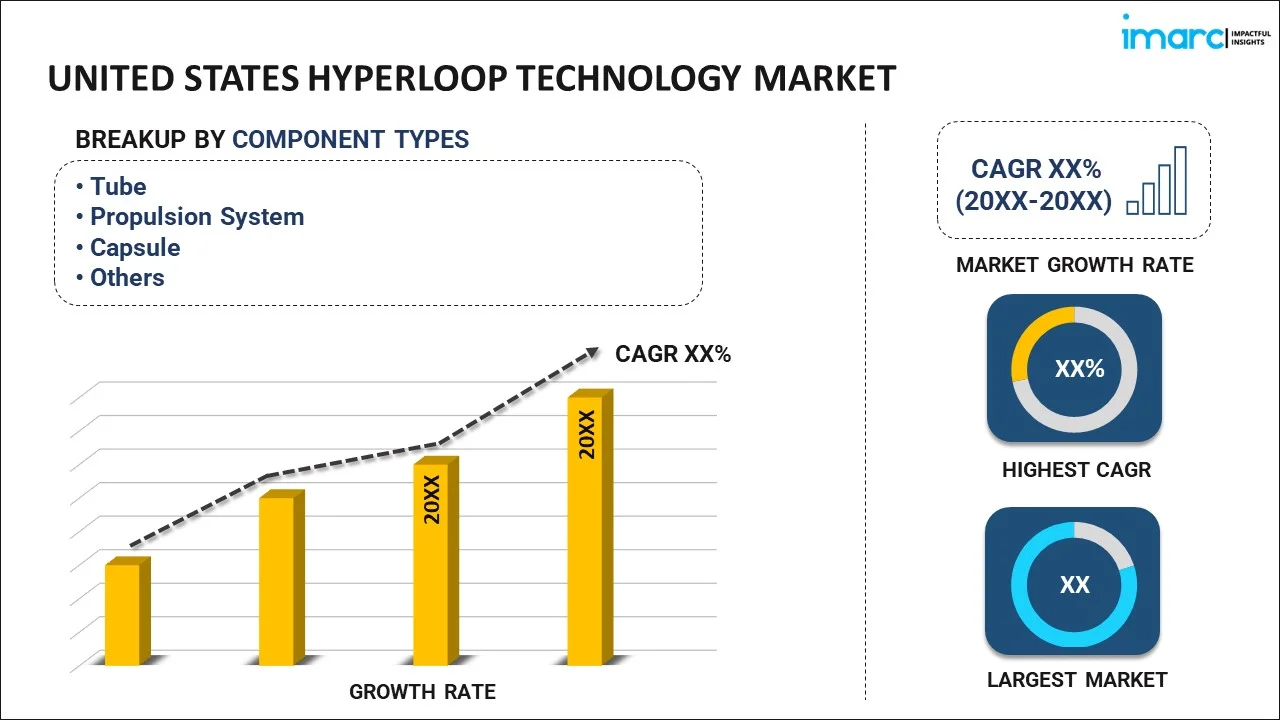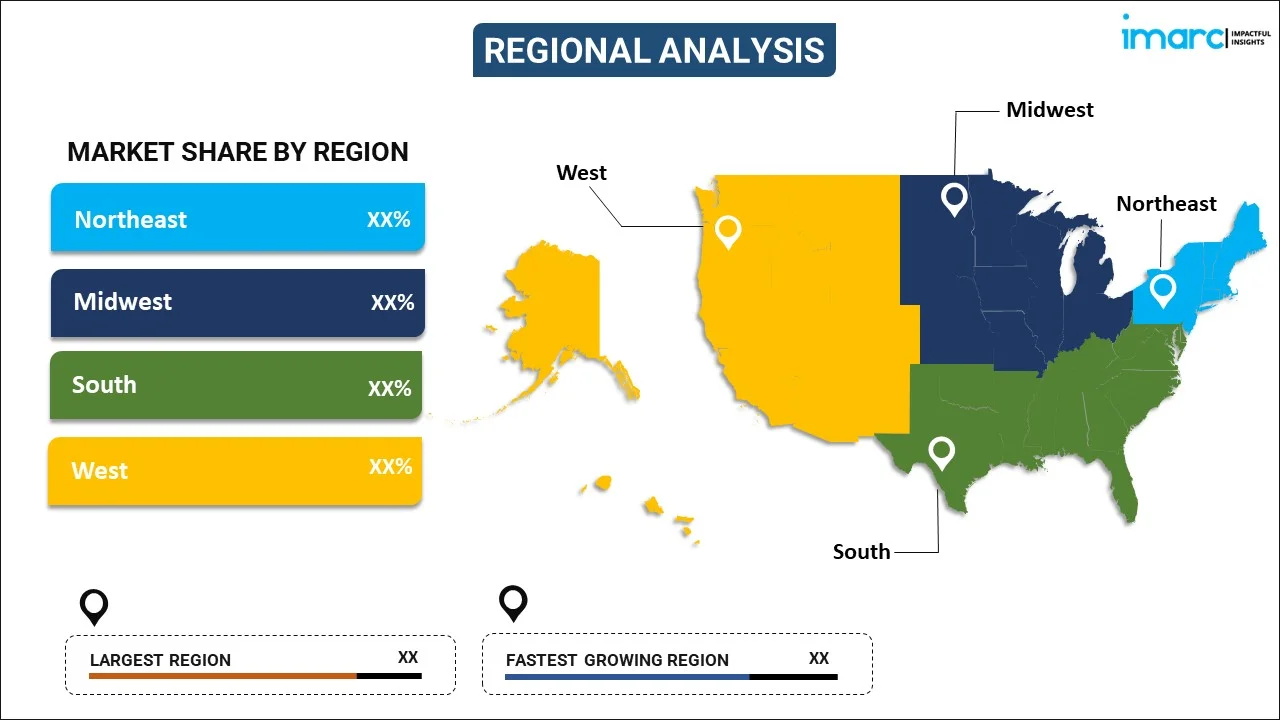
United States Hyperloop Technology Market Report by Component Type (Tube, Propulsion System, Capsule, and Others), Speed (More than 700 kmph, Less than 700 kmph), Carriage Type (Passenger, Cargo/Freight), and Region 2025-2033
Market Overview:
United States hyperloop technology market size reached USD 620 Million in 2024. Looking forward, IMARC Group expects the market to reach USD 17,800 Million by 2033, exhibiting a growth rate (CAGR) of 45.3% during 2025-2033. The inflating need among key players for offering a glimpse into the future of high-speed and sustainable transportation is primarily driving the regional market.
|
Report Attribute
|
Key Statistics
|
|---|---|
|
Base Year
|
2024
|
|
Forecast Years
|
2025-2033
|
|
Historical Years
|
2019-2024
|
|
Market Size in 2024
|
USD 620 Million |
|
Market Forecast in 2033
|
USD 17,800 Million |
| Market Growth Rate 2025-2033 | 45.3% |
Hyperloop technology proposes a transportation system that utilizes low-pressure tubes for high-speed movement of passengers and cargo. Initially conceived as a means for swift intercity travel, the concept involves pods levitating on electromagnetic fields within a vacuum. Analogous to the pneumatic tubes found in banks for transporting paperwork, the hyperloop system operates on a larger scale, incorporating pods for both passenger and cargo transport. The low-pressure environment minimizes air resistance, allowing the pods to travel rapidly and efficiently with minimal energy consumption. A key aspect is the intention for the system to be powered by renewable energy sources, contributing to its environmentally friendly and sustainable profile. Currently in the developmental stage, various companies are working on prototypes and testing different aspects of hyperloop technology. If successful, hyperloop has the potential to revolutionize long-distance transportation, providing a faster, safer, and more efficient alternative to traditional modes of travel such as flying and driving.
United States Hyperloop Technology Market Trends:
The United States hyperloop technology market is witnessing fervent innovation and development as it strives to revolutionize the transportation sector. Envisioned as pods levitating on electromagnetic fields within vacuum tubes, this technology holds the promise of rapid, energy-efficient transportation between major cities. Additionally, the hyperloop system, drawing inspiration from pneumatic tubes in banks, is scaled up to accommodate both passengers and cargo, which is acting as another significant growth-inducing factor. Besides this, an integral aspect of the United States hyperloop market is its commitment to sustainability, with plans for the system to run on renewable energy sources, aligning with broader environmental goals. Moreover, multiple companies in the country are actively engaged in developing and testing hyperloop prototypes, exploring various technological features, thereby bolstering the market growth across the country. The potential success of hyperloop technology could redefine long-distance transportation by providing a faster, safer, and more efficient alternative, ultimately transforming the landscape of travel and logistics in the country. As the technology matures, the United States hyperloop market is poised for substantial growth over the forecasted period.
United States Hyperloop Technology Market Segmentation:
IMARC Group provides an analysis of the key trends in each segment of the market, along with forecasts at the country level for 2025-2033. Our report has categorized the market based on component type, speed, and carriage type.
Component Type Insights:

- Tube
- Propulsion System
- Capsule
- Others
The report has provided a detailed breakup and analysis of the market based on the component type. This includes tube, propulsion system, capsule, and others.
Speed Insights:
- More than 700 kmph
- Less than 700 kmph
A detailed breakup and analysis of the market based on speed have also been provided in the report. This includes more than 700 kmph and less than 700 kmph.
Carriage Type Insights:
- Passenger
- Cargo/Freight
The report has provided a detailed breakup and analysis of the market based on the carriage type. This includes passenger and cargo/freight.
Regional Insights:

- Northeast
- Midwest
- South
- West
The report has also provided a comprehensive analysis of all the major regional markets, which include the Northeast, Midwest, South, and West.
Competitive Landscape:
The market research report has also provided a comprehensive analysis of the competitive landscape in the market. Competitive analysis such as market structure, key player positioning, top winning strategies, competitive dashboard, and company evaluation quadrant has been covered in the report. Also, detailed profiles of all major companies have been provided.
United States Hyperloop Technology Market Report Coverage:
| Report Features | Details |
|---|---|
| Base Year of the Analysis | 2024 |
| Historical Period | 2019-2024 |
| Forecast Period | 2025-2033 |
| Units | Million USD |
| Scope of the Report | Exploration of Historical Trends and Market Outlook, Industry Catalysts and Challenges, Segment-Wise Historical and Future Market Assessment:
|
| Component Types Covered | Tube, Propulsion System, Capsule, Others |
| Speeds Covered | More than 700 kmph, Less than 700 kmph |
| Carriage Types Covered | Passenger, Cargo/Freight |
| Regions Covered | Northeast, Midwest, South, West |
| Customization Scope | 10% Free Customization |
| Post-Sale Analyst Support | 10-12 Weeks |
| Delivery Format | PDF and Excel through Email (We can also provide the editable version of the report in PPT/Word format on special request) |
Key Questions Answered in This Report:
- How has the United States hyperloop technology market performed so far and how will it perform in the coming years?
- What has been the impact of COVID-19 on the United States hyperloop technology market?
- What is the breakup of the United States hyperloop technology market on the basis of component type?
- What is the breakup of the United States hyperloop technology market on the basis of speed?
- What is the breakup of the United States hyperloop technology market on the basis of carriage type?
- What are the various stages in the value chain of the United States hyperloop technology market?
- What are the key driving factors and challenges in the United States hyperloop technology?
- What is the structure of the United States hyperloop technology market and who are the key players?
- What is the degree of competition in the United States hyperloop technology market?
Key Benefits for Stakeholders:
- IMARC’s industry report offers a comprehensive quantitative analysis of various market segments, historical and current market trends, market forecasts, and dynamics of the United States hyperloop technology market from 2019-2033.
- The research report provides the latest information on the market drivers, challenges, and opportunities in the United States hyperloop technology market.
- Porter's five forces analysis assist stakeholders in assessing the impact of new entrants, competitive rivalry, supplier power, buyer power, and the threat of substitution. It helps stakeholders to analyze the level of competition within the United States hyperloop technology industry and its attractiveness.
- A competitive landscape allows stakeholders to understand their competitive environment and provides an insight into the current positions of key players in the market.
Need more help?
- Speak to our experienced analysts for insights on the current market scenarios.
- Include additional segments and countries to customize the report as per your requirement.
- Gain an unparalleled competitive advantage in your domain by understanding how to utilize the report and positively impacting your operations and revenue.
- For further assistance, please connect with our analysts.
 Request Customization
Request Customization
 Speak to an Analyst
Speak to an Analyst
 Request Brochure
Request Brochure
 Inquire Before Buying
Inquire Before Buying




.webp)




.webp)












